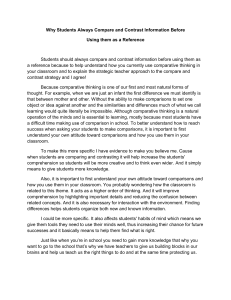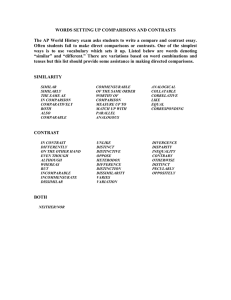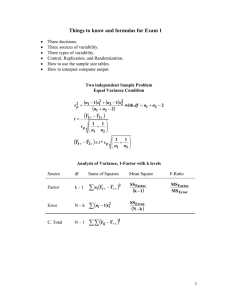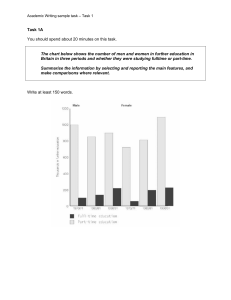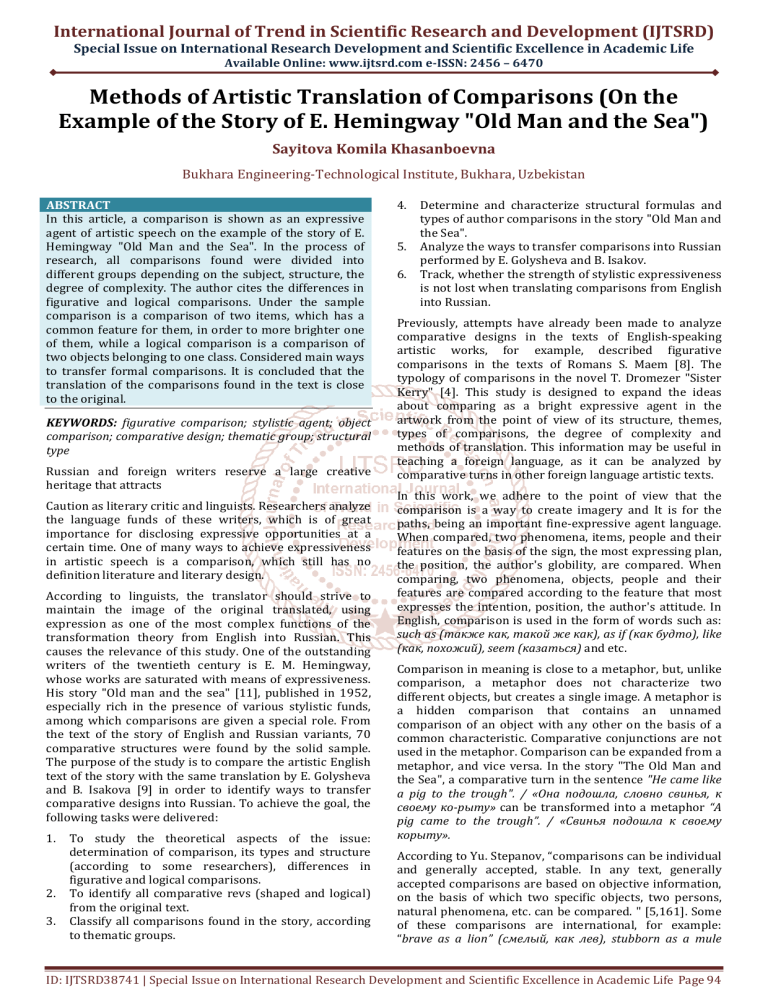
International Journal of Trend in Scientific Research and Development (IJTSRD)
Special Issue on International Research Development and Scientific Excellence in Academic Life
Available Online: www.ijtsrd.com e-ISSN: 2456 – 6470
Methods of Artistic Translation of Comparisons (On the
Example of the Story of E. Hemingway "Old Man and the Sea")
Sayitova Komila Khasanboevna
Bukhara Engineering-Technological Institute, Bukhara, Uzbekistan
ABSTRACT
In this article, a comparison is shown as an expressive
agent of artistic speech on the example of the story of E.
Hemingway "Old Man and the Sea". In the process of
research, all comparisons found were divided into
different groups depending on the subject, structure, the
degree of complexity. The author cites the differences in
figurative and logical comparisons. Under the sample
comparison is a comparison of two items, which has a
common feature for them, in order to more brighter one
of them, while a logical comparison is a comparison of
two objects belonging to one class. Considered main ways
to transfer formal comparisons. It is concluded that the
translation of the comparisons found in the text is close
to the original.
KEYWORDS: figurative comparison; stylistic agent; object
comparison; comparative design; thematic group; structural
type
Russian and foreign writers reserve a large creative
heritage that attracts
Caution as literary critic and linguists. Researchers analyze
the language funds of these writers, which is of great
importance for disclosing expressive opportunities at a
certain time. One of many ways to achieve expressiveness
in artistic speech is a comparison, which still has no
definition literature and literary design.
According to linguists, the translator should strive to
maintain the image of the original translated, using
expression as one of the most complex functions of the
transformation theory from English into Russian. This
causes the relevance of this study. One of the outstanding
writers of the twentieth century is E. M. Hemingway,
whose works are saturated with means of expressiveness.
His story "Old man and the sea" [11], published in 1952,
especially rich in the presence of various stylistic funds,
among which comparisons are given a special role. From
the text of the story of English and Russian variants, 70
comparative structures were found by the solid sample.
The purpose of the study is to compare the artistic English
text of the story with the same translation by E. Golysheva
and B. Isakova [9] in order to identify ways to transfer
comparative designs into Russian. To achieve the goal, the
following tasks were delivered:
1.
2.
3.
To study the theoretical aspects of the issue:
determination of comparison, its types and structure
(according to some researchers), differences in
figurative and logical comparisons.
To identify all comparative revs (shaped and logical)
from the original text.
Classify all comparisons found in the story, according
to thematic groups.
4.
5.
6.
Determine and characterize structural formulas and
types of author comparisons in the story "Old Man and
the Sea".
Analyze the ways to transfer comparisons into Russian
performed by E. Golysheva and B. Isakov.
Track, whether the strength of stylistic expressiveness
is not lost when translating comparisons from English
into Russian.
Previously, attempts have already been made to analyze
comparative designs in the texts of English-speaking
artistic works, for example, described figurative
comparisons in the texts of Romans S. Maem [8]. The
typology of comparisons in the novel T. Dromezer "Sister
Kerry" [4]. This study is designed to expand the ideas
about comparing as a bright expressive agent in the
artwork from the point of view of its structure, themes,
types of comparisons, the degree of complexity and
methods of translation. This information may be useful in
teaching a foreign language, as it can be analyzed by
comparative turns in other foreign language artistic texts.
In this work, we adhere to the point of view that the
comparison is a way to create imagery and It is for the
paths, being an important fine-expressive agent language.
When compared, two phenomena, items, people and their
features on the basis of the sign, the most expressing plan,
the position, the author's globility, are compared. When
comparing, two phenomena, objects, people and their
features are compared according to the feature that most
expresses the intention, position, the author's attitude. In
English, comparison is used in the form of words such as:
such as (также как, такой же как), as if (как будто), like
(как, похожий), seem (казаться) and etc.
Comparison in meaning is close to a metaphor, but, unlike
comparison, a metaphor does not characterize two
different objects, but creates a single image. A metaphor is
a hidden comparison that contains an unnamed
comparison of an object with any other on the basis of a
common characteristic. Comparative conjunctions are not
used in the metaphor. Comparison can be expanded from a
metaphor, and vice versa. In the story "The Old Man and
the Sea", a comparative turn in the sentence "He came like
a pig to the trough". / «Она подошла, словно свинья, к
своему ко-рыту» can be transformed into a metaphor “A
pig came to the trough”. / «Свинья подошла к своему
корыту».
According to Yu. Stepanov, “comparisons can be individual
and generally accepted, stable. In any text, generally
accepted comparisons are based on objective information,
on the basis of which two specific objects, two persons,
natural phenomena, etc. can be compared. " [5,161]. Some
of these comparisons are international, for example:
“brave as a lion” (смелый, как лев), stubborn as a mule
ID: IJTSRD38741 | Special Issue on International Research Development and Scientific Excellence in Academic Life Page 94
International Journal of Trend in Scientific Research and Development (IJTSRD) @ www.ijtsrd.com eISSN: 2456-6470
(упрямый, как осел) and etc. Individual comparisons
create a unique look to the item: “I wandered lonely as a
cloud”. / «Я одиноко брёл словно облако».
A.I. Efimov distinguishes in the structure of comparison
“the subject of comparison (what is being compared), the
object of comparison (what is being compared with), the
basis of comparison” [1,224]. N.D. Arutyunova operates
with other names: “…the object is what is compared, the
image is what the attribute is compared with, on the basis
of which the comparison of the first two is made” [7, 204].
There are figurative (simile) and logical (comparison)
comparisons. In a logical comparison, all properties of two
objects are taken into account, but one is highlighted and
compared. For figurative comparisons, an element of
fiction, fantasy is characteristic. It is well known that the
basis of any stylistic effect lies in unpredictability, because
the recipient of information in reality acquires something
completely different from what he initially tuned in [3]. To
successfully implement a logical (non-descriptive)
comparison it is necessary to compare homogeneous
concepts that reflect “homogeneous objects and
phenomena of objective reality” [2,568]. And in figurative
comparative units, concepts that are far from each other
are most often compared. However, it is not always
possible to distinguish a figurative comparison from an
ordinary logical comparison. In the expression “Oh, John
could do this forty times better than I”. / «Джон смог это
сделать в 40 раз лучше, чем я» an exaggeration is
evident, which makes the comparison figurative, despite
the fact that John and the speaker belong to a class of
people.
Since the object of the study is E. Hemingway's story "The
Old Man and the Sea", now it is necessary to dwell on it in
detail. In the center of the plot is the old fisherman
Santiago, who, after 84 days of an unsuccessful catch, does
not lose heart, believing that on the 85th day he will be
lucky and he will catch a big fish. You just need to move
away from the coast. And he was right: in the end he
caught a big fish - marlin. Several days of fighting with fish
and sharks exhausted the old man. Unfortunately, from
Santiago's biggest catch, only the head and sword of a
marlin were left. To achieve the goal, all comparisons by
the author were classified into thematic groups, structural
types, and also highlighted comparisons according to the
degree of complexity. The following thematic groups of
comparisons related to the image of the main character the old fisherman Santiago:
1.
2.
3.
4.
Sea (48): “His sword was as long as a baseball bat and
tapered like a rapier”. / «Вместо носа у нее был меч,
длинный, как бейсбольная клюшка, и острый на
конце, как рапира».
Appearance (3): “…they were the same color as the
sea”. / «…глаза были цветом похожи на море».
Характер (15): “Keep your head clear and know how to
suffer like a man”. / «Приведи свои мысли в порядок и
постарайся переносить страдания, как человек».
Nature (4): “The clouds over the land now rose like
mountains…”. / «Облака над землей возвышались
теперь, как горная гряда …».
The structures of the author's comparisons in the story
"The Old Man and the Sea" are very diverse. Knowledge
structural type of comparisons, as the study shows, greatly
facilitates the process of their translation. Several formulas
of figurative comparisons characteristic of the English
language, proposed by M.D. Kuznets, who divides
comparisons by parts of speech that are used in their
structure [6]:
1) (as) + adj. / нар. + a s + noun.: “They were not t he o
rdinary p yramid-shaped teeth of most sharks. They were
nearly as long as the fingers of the old man…”. / «Они были
не похожи на обычные пирамидальные зубы
большинства акул. Длиною они не уступали пальцам
старика…». The word “long” is already given in a
figurative comparison. It is attached to another component
of the construction - the comparison object (the fingers)
using the union as. The semantic analysis of this phrase
suggests that the teeth of the shark, with which the
fearless old man had to fight once again, were huge, the
same length as his fingers;
2) linking verb + like + (adj.) + noun :“His shirt had been
patched so many times that it was like the sail”. A figurative
comparison means that the main character was poor, as can
be judged by his clothes: его латаная-перелатаная
рубаха сопоставляется с парусом, который тоже был
весь в заплатах из мешковины;
3) verb + like + (adj.) + noun: Sentences containing a
figurative comparison of this type characterize the action
expressed by the verb. The person who performs the
action becomes the subject of comparison, and what the
hero is compared with becomes an object: “They played
like young cats ...”. In this example, we are talking about
Santiago's dreams of distant lands, in which lion cubs,
coming out to the seashore and frolicking in the gloomy
haze, are compared to kittens. He dreamed of neither
women, nor great events, nor fights, nor big fish, namely
lion cubs, perhaps because their image gave the old man
pleasure and at the same time caused him nostalgia for a
long-gone youth;
4) in negative form: “He is not a scavenger nor just a
moving appetite as some sharks are. He is beautiful and
noble and knows nor fear of anything ”. This comparison
shows that the dentuso shark differs from other sharks in
that it does not just devour carrion and not just an
insatiable womb like them, but it is a beautiful and noble
animal that does not know what fear is. Santiago, of
course, is sorry that he had to kill her, but he defended his
life, because everyone is killing someone or something in
one way or another;
5) with a comparative adjective: “He… watched the lines
that went straight down into the dark of the water. He kept
them straighter than anyone did ... ”. / «Он… смотрел в
глубь моря, куда уходили его лески. У него они всегда
уходили в воду прямее, чем у других рыбаков…».
Obviously, in this way the author wanted to emphasize the
ability of the fisherman Santiago to do everything in the
right way, especially if the case related to fishing;
6) by means of allied adverbs as though, as if, introducing a
relative comparison. The type of comparison with such a
structure usually represents a construction in which not
individual objects are compared, but the situations or
states of the characters: “When the fish had been hit it was
as though he himself were hit”. We see that in this example,
after the union adverb as though (as if, as if), the
subjunctive mood is used, as indicated by the form were
hit. In this example, the anxiety state of the old man is
ID: IJTSRD38741 | Special Issue on International Research Development and Scientific Excellence in Academic Life Page 95
International Journal of Trend in Scientific Research and Development (IJTSRD) @ www.ijtsrd.com eISSN: 2456-6470
clearly traced at the moment when the shark rushed to the
fish. It seemed to him that she rushed at him. Each time the
old man entered into a fight with sharks, protecting his
rather tortured prey - a huge marlin, trying to take it to the
shore.
In the text of the story, basically all comparisons are
figurative, but examples of some logical comparisons were
also recorded: “Maybe he was as poor as we are and would
understand”. In this sentence, the old man argues that
perhaps he and Father DiMaggio belonged to the same
class - the poor. This comparison is used to logically
compare two objects and does not carry any figurative
characteristics: the old man Santiago and father DiMaggio
are united by one property - poverty. According to
grammatical and lexical-semantic features, all comparative
constructions in the story are divided into two groups:
simple and complex. The following example can be
referred to as simple ones: “… as a bubble…”. A complex
comparison is a whole sentence: “…as something that gave
or withheld great favours”.
The words that are the object (associate) of comparison in
the text of this work refer mainly to the noun: “to suffer
like a man”, “tapered like a rapier”, “as old as erosions”, less
often - to the personal pronoun: “Never have I seen a
greater… thing than you, brother ”. When working on the
comparison of English comparisons of their translation by
E. Golysheva and B. Izakov, the following translation
methods were identified:
1.
Syntactic assimilation (literal translation): “… like a
male and he pulls like a male…”. / «…как самец и он
тянет как самец…».
2.
Grammatical substitution, a common occurrence of
which is part of speech substitution: “… As it keeps me
alive”. The adjective alive has been replaced by the
Russian verb “умереть” in translation. Literally the
comparison would be framed like this: "она (рыбная
ловля)… держит меня живым”. But the translators
felt that literal translation would complicate the
reader's perception, and therefore chose a
grammatical substitution method. But the translators
felt that literal translation would complicate the
reader's perception, and therefore chose a
grammatical substitution method.
3.
Adding is a process that requires the dissemination of
some contracted language from the point of view of
the TL (target language) in the original language
turnover: “… like the backing of mirrors”. / “…которой
покрывают оборотную сторону зеркала”.
4.
Omission is the removal of certain elements of the
source text due to their redundancy from the point of
the TL: “… as long as the one room of the shack” /
«…такой же длины, как хижина».
5.
Reception of semantic development: “… it looked like
the flag of permanent defeat”. /«…он (парус)
напоминал знамя наголову разбитого полка».
6.
Permutation is a change in the arrangement (order) of
linguistic elements in the translation text in
comparison with the original text: “They were nearly as
long as the fingers of the old man”. / “Длиною они не
уступали пальцам старика”.
7.
Dividing a sentence - consists in transforming a simple
or complex sentence of the source language into two
or more independent sentences in the target language:
“… only the tops of the blue hills that showed white as
though they were snow-capped and the clouds that
looked like high snow mountains above them ”. /
“…вдали вырисовывались лишь верхушки голубых
холмов, которые отсюда казались белыми, словно
были одеты снегом. Облака над ними тоже были
похожи на высокие снежные горы”.
8.
Preservation of the comparison in the Russian
translation, despite its absence in the original text. For
example, in the English sentence “The old man ... lifted
the burnished gold fish with its purple spots over the
stem”. / «Старик… втащил в лодку жаркую, как
золото, рыбу с фиолетовыми разводами», there is
no comparison, while in the Russian translation it
appears: “золотая рыба”(gold fish) turns into ”рыбу,
как золото”.
9.
Lack of comparative conjunctions in Russian
translation. For example, the sentence “Each line, as
thick around as a big pencil ”should sound like this:
«Каждая леса такая же толстая, как большой
карандаш», but the translators changed the structure
of the sentence, omitting the conjunctions when
translating «такой же, как» (as… as): «Каждая леса
толщиной с большой карандаш».
The study led to the conclusion that basically everything,
with the exception of a few examples, is comparable in the
story are figurative, while retaining the power of their
stylistic expressiveness. The most common structures of
figurative comparisons in the story "The Old Man and the
Sea" are the structures: verb + like + (adj.) + Noun. and
(as) + adj. / bed. + as + n. Comparisons are mostly nouns.
The most popular thematic group of comparisons is the
"Sea" group, which includes figurative and some logical
comparisons concerning the catch of fish, the thoughts of
the old man while fishing and the attitude to reality.
Throughout the story, the images of the sea, sky and wind
undergo changes, their emotional background changes.
These images show that time goes by for a very long time.
If at the beginning of the story the time “is not constrained
by narrow frames, presenting the life of Cuban fishermen
and the old man's past, then at the moment of a fight with
a fish it narrows to a gorge of clouds ”[10, 29].
Consideration of comparisons within the framework of the
above classifications reveals the essence of the stylistic
device of comparison in the story "The Old Man and the
Sea", being also an effective stylistic means of
characterizing the main character - the fisherman
Santiago, assessing his behavior, role and emotional state.
Among the common methods of translation, syntactic
assimilation was recorded, grammatical substitution and
semantic development. A feature of the translation of
figurative comparisons in the story is its closeness to the
original text. In a number of cases, comparisons are not
transmitted directly, but for the convenience of perception
by the reader are presented by more understandable
language means. In some cases translators prefer to omit
comparative conjunctions or to introduce comparisons in
the absence of a comparative phrase in the English text.
When translating figurative comparisons, the possibilities
ID: IJTSRD38741 | Special Issue on International Research Development and Scientific Excellence in Academic Life Page 96
International Journal of Trend in Scientific Research and Development (IJTSRD) @ www.ijtsrd.com eISSN: 2456-6470
of the Russian language turn out to be richer than that of
the English language.
turno_semanticheskiy_analiz_
obraznyh_sravneniy_hudozhestvennom_tekste
(data obrasheniya: 21.02.2018).
REFERENCES:
[1] Yefimov A. I. Stilistika xudojestvennoy rechi. M.:
MGU, 1991. 508 s.
[7]
Tomashevskiy B. V. Stilistika. L.: Izd-vo Leningr. unta, 1983. 283 s.
[2]
Kondakov N. I. Logicheskiy slovar'-spravochnik. Izde 2-e. M.: Nauka, 1975. 720 s.
[8]
[3]
Moroxovskiy A. N., Vorob'yova O. P., Lixosherst N. I.,
Timoshenko Z. V. Stilistika angliyskogo yazika. K.:
Vishaya shkola, 1984. 241 s.
Funksii obraznogo sravneniya v tekstax romanov S.
Moema
[Elektronniy
resurs].
URL:
https://cyberleninka.ru/
article/v/funktsiiobraznogo-sravneniya-v-tekstah-romanov-smoema (data obrasheniya: 10.03.2018).
[4]
Sravnitel'no-sopostavitel'niy analiz stilisticheskoy
virazitel'nosti i sredstv yee aktualizasii v
angliyskom i russkom yazikax [Elektronniy resurs].
URL:
http://www.bestreferat.ru/referat209961.html (data obrasheniya: 11.03.2018).
[9]
Xeminguey E. Sobranie sochineniy: v 4-x t. M.:
Xudojestvennaya literatura, 1968. T. 4. 735 s.
[10]
Chugunova N. A. Prostranstvenno-vremennie
otnosheniya v povestyax E. Xemingueya «Starik i
more» i Ch. Aytmatova «Pegiy pes, begushiy kraem
morya» // Nasional'naya spesifika proizvedeniy
zarubejnoy literaturi XIX-XX vekov / otv. red. A. N.
Taganov. Ivanovo, 1984. S. 28-29.
[11]
Hemingway E. The old man and the sea
[Электронный
ресурс].
URL:
http://booksonline.com.ua/view.php?book=13932
4page2
[5]
Stepanov Yu. Fransuzskaya stilistika. M.: Visshaya
shkola, 1965. 355 s.
[6]
Strukturno-semanticheskiy
analiz
obraznix
sravneniy v xudojestvennom tekste [Elektronniy
resurs]
URL:http://studbooks.net/773363/literatura/struk
ID: IJTSRD38741 | Special Issue on International Research Development and Scientific Excellence in Academic Life Page 97

